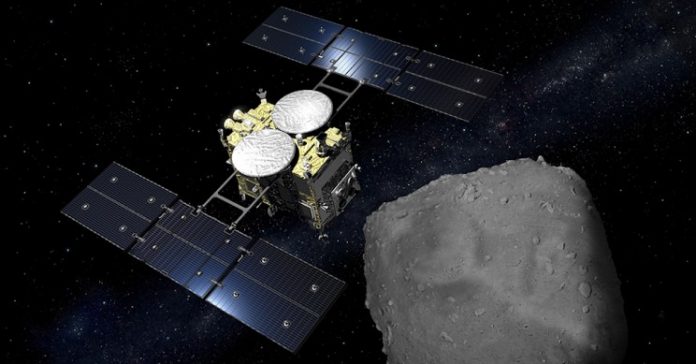The Hayabusa2 spacecraft dropped explosives onto the asteroid Ryugu’s surface to create a crater that it could study.
Japan has dropped explosives onto the asteroid Ryugu in order to create a new crater to study. The hardworking Hayabusa2 spacecraft undertook the risky procedure on Friday. The Japan Aerospace Exploration Agency, or JAXA, said the mission was the first step in attempting to collect underground asteroid samples for possible clues to the origin of the solar system.
JAXA confirmed that the spacecraft Hayabusa2 dropped a small explosive box called the Small Carry-on Impactor (SCI) which sent a copper ball the size of a baseball slamming into the asteroid. To avoid damage from the impact and flying particles Hayabusa2 needed to move out of the way to the other side of the asteroid.
Data received from the spacecraft indicates that it escaped unharmed and that everything is operating normally. The spacecraft deployed a small camera moments before making its escape Which was able to capture the moment of detonation on the asteroid’s surface from a distance of about 1 km (0.6 miles).
Hayabusa2 will now return to the blasted side of the asteroid to collect the samples from the explosion. It will wait until all the dust and debris for the explosion has settled before attempting to move back towards the new crater.
History of the Solar System Unlocked
The missions scientist hope that the samples collected will give them new insight into the history of the solar system as asteroids are leftover material from its formation. This will be the first time that underground asteroid samples have ever been collected.
NASA undertook a “deep impact” mission where they blasted the surface of a comet but only observed the resulting agitated surface. So far the Hayabusa2 mission has completed a huge amount of scientific research. It has already collected samples from the surface of the asteroid Ryugu by firing a bullet at it and last month JAXA announced they had detected hydroxyl-bearing minerals on the asteroid by analyzing near-infrared spectrometer readings by the spacecraft.
This incredible discovery could go some way to explaining where the Earth’s water came from. The results were published in the online edition of Science magazine. The mission researchers say it is too early to celebrate the historic efforts of Hayabusa2 and that they have many more missions for the spacecraft left to complete.
Hayabusa2 is scheduled to depart the asteroid at the end of 2019 and bring the surface fragments and underground samples back to Earth in late 2020. Ryugu is named after an undersea palace in a Japanese folktale, it is about 300 million kilometers (180 million miles) from Earth.















